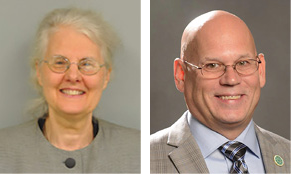By Charles Dull and Jeanette Evans | STC Associate Fellow
 This column investigates emerging technologies in education and how we might use them in our work. Whether it is social media, wearable technologies, the latest in printers, personalization, big data, BYOD, cloud computing, mobile apps, MOOCs, analytics, digital identity, haptic interfaces, augmented reality, or the Internet of Things, we can all benefit from current thinking on these technologies. Contact the columnists at jeanette.evans@sbcglobal.net.
This column investigates emerging technologies in education and how we might use them in our work. Whether it is social media, wearable technologies, the latest in printers, personalization, big data, BYOD, cloud computing, mobile apps, MOOCs, analytics, digital identity, haptic interfaces, augmented reality, or the Internet of Things, we can all benefit from current thinking on these technologies. Contact the columnists at jeanette.evans@sbcglobal.net.
Higher education must continue to meet the learning needs of a changing society. The challenge can come with faculty that fail to change their dated ideas, continue to show their inability to understand how people learn, and refuse to adapt. We are seeing some change in the academy already, and even seeing projections of fewer institutions of higher learning. Consider that we could lose sight of what society and students need and how to build to meet those learning needs.
Consider also how we in our technical communication communities must also meet the needs of a changing society. We should be careful not to resist when it comes to changing our dated ideas. We should also understand how people learn today and continue to adapt.
In the academic setting, we can go to a group of students who are studying in a building and ask if they like online learning. They say they do not. We assume the desire for online learning is declining, and we need more in-person classes. Of course, if you go to students that take only online classes, they might say that online is best. They could also say that at times online is the only way they can attend college, and we need more online classes. It is not a matter of getting the “right” answer.
A researcher who never took an online class and has a limited understanding of instructional design could conduct the study. This researcher could find that online is a low-quality method of distributing learning. In a way, they found what they hoped to find. We can also look at other faculty who see themselves as experts in the field and collaborate with instructional designers. They believe they build high-quality content for online classes.
We have a complex model that is constantly changing. It is also a complicated model of how students learn. Learning in the Internet of Everything era is open. It is not confined by strictures, structures, and dated pedagogies.
There is also the dynamic of students. There could be a critical mass of students who want a certain learning method or mode of delivery. There could be points at which student populations are seen as a whole, wanting all methods and modes of learning. They want it to meet their needs when those needs need arise. This suggests that learning is no longer a complication but intrinsically complex.
In a way, we ignore the best learning models. Consider that the pace of learning for the first five years of life is greater than at any other point. We continue to think learning occurs when you sit down, keep quiet, do what I do, learn to say what I say, and pass this test that the government says is good. We can call that learning, and pat ourselves on the back.
We even ignore the giants of technology and how they learned. It was complex, and typically did not fit the current model of learning. It is time to throw out old models. In an age of digitization, didactic models do not deliver the outcomes needed for the Internet of Everything.
We need leaders for this new age of learning. What we currently have for this task are followers. When there is an innovation in one college, others rush to copy. Then they wonder why one model will not work everywhere. They fail to understand that learning is complex. Complex systems require leaders who do not look for someone or some system to mimic. They understand the complex nature of learning and make visionary decisions to meet the learning needs of those who will live in the Internet of Everything.
Resource
Dull, Charles. “Learning in the Internet of Everything Era.” The Evolllution. 6 July 2017. https://evolllution.com/revenue-streams/distance_online_learning/learning-in-the-internet-of-everything-era/.


